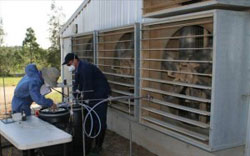



Get the Dirt on Dust and Odour Emissions
AUSTRALIA - The final reports from the most comprehensive Australian study of Dust and Odour Emissions from Poultry Sheds are now available.
This ambitious project collected high quality data on dust and odour emissions from both layer and broiler tunnel ventilated sheds, which is presented in two reports, namely, Dust and Odour Emissions from Layer Sheds and Dust and Odour Emissions from Meat Chicken Sheds.
A combination of advances in emission measurement practices including new olfactometry and dust measurement standards, improved sample collection methods and the use of alternative measurement technologies such as electronic sensing arrays and gas chromatography-mass spectrometry/olfactometry (GC-MS/O) provided accurate and up-to-date data for the emissions. In the broiler sheds, an artificial olfaction system (AOS) or ‘electronic nose’ was able to successfully measure in-shed odour concentration and enabled continuous measurement of odour emissions when combined with ventilation rate data.


The project strove to develop a comprehensive odour emissions model. But this goal proved elusive. Individual models based on three of the broiler farms could not be reconciled because of the variability in the odour emission rate data between those farms. Given this, the use of the models developed in this project to predict odour emission rates at other farms is not recommended.
As the project leader, Mark Dunlop, explained, "The objective of collecting data in the project was to improve planning for new farms. The data we collected showed odour emissions were similar to previously reported data, so the project should not have too much of an effect on dispersion modelling."
The project has significantly enhanced our understanding of the many variables influencing the emission of odour and dust from Australian poultry sheds and improved sampling and analytical methods suitable for the study of emissions from the highly complex biological and mechanical system of a modern poultry farm.









